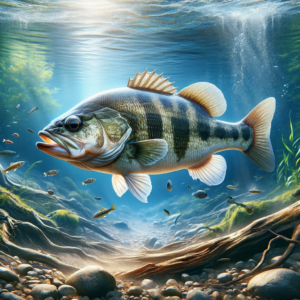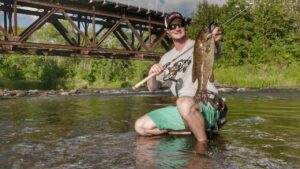What types of fish make up the diet of smallmouth bass? As an angler, it’s important to understand the prey preferences of your target species in order to increase your chances of a successful catch. In this article, we will delve into the world of smallmouth bass and explore the various fish that they commonly prey upon. By the end of this guide, you will have a comprehensive understanding of the prey preferences of smallmouth bass, allowing you to make informed decisions when it comes to selecting the right fishing lures and techniques.
Smallmouth bass, known for their fierce fighting abilities and impressive size, are opportunistic predators that feed on a wide range of fish species. They are known to prey on both small fish, such as minnows and shiners, as well as larger fish, such as sunfish and trout. Their preference for different fish species may vary depending on factors such as location, time of year, and availability of prey. By understanding the common prey species of smallmouth bass, anglers can tailor their fishing strategies to increase their chances of success.
One common prey species that smallmouth bass target is the crayfish. These freshwater crustaceans make up a significant portion of the smallmouth bass diet, especially in rocky or sandy habitats where crayfish are abundant. Crayfish provide smallmouth bass with a high protein meal, and their availability throughout the year makes them an attractive food source. Understanding the behavior and habitat preferences of crayfish can help anglers effectively mimic their movements and increase their chances of enticing a hungry smallmouth bass.
Another common prey species for smallmouth bass are baitfish, such as minnows and shiners. These small fish are often found in schools, making them an easy target for the smallmouth bass. Baitfish are known for their quick movements, which triggers the predatory instincts of the smallmouth bass. By mimicking the appearance and erratic movements of baitfish with the right lures, anglers can effectively attract and entice nearby smallmouth bass.
In conclusion, understanding the prey preferences of smallmouth bass is essential for any angler looking to target this species. By familiarizing yourself with the various fish species that smallmouth bass commonly prey upon, you can make informed decisions when it comes to selecting fishing lures, techniques, and locations. Whether you choose to imitate crayfish or baitfish, remember to observe the behavior and habitat preferences of your target species to maximize your chances of a successful catch. So, let’s dive into the world of smallmouth bass prey and expand our knowledge on this fascinating topic.
A Guide to the Prey of Smallmouth Bass
Smallmouth bass, also known as smallies, are a popular sport fish found in many freshwater bodies across North America. They are known for their aggressive and voracious feeding habits, and they consume a wide variety of prey to meet their dietary needs. In this guide, we will explore the different types of fish that are consumed by smallmouth bass, as well as the factors that influence their prey selection and the implications of this selection on their population and ecosystem.
Types of Fish Consumed by Smallmouth Bass
Minnows
Minnows are small, elongated fish that belong to the family Cyprinidae. They are one of the primary prey items for smallmouth bass. Minnows are characterized by their slender bodies, small mouths, and streamlined shape, which makes them an easy target for smallmouth bass. They can be found in abundance in many freshwater lakes, rivers, and streams, making them readily available for smallies to feast upon.
There are several reasons why minnows are a preferred prey for smallmouth bass. Firstly, minnows are rich in protein and essential nutrients, making them a valuable source of energy for the bass. Secondly, their small size allows smallmouth bass to consume them easily without expending much energy. Finally, minnows often form large schools, which makes them an attractive target for smallmouth bass looking to feed quickly and efficiently.
Some of the common types of minnows consumed by smallmouth bass include the fathead minnow, golden shiner, and bluntnose minnow. These minnows vary in size, coloration, and behavior, but all serve as important prey items for smallmouth bass.
Crayfish
Crayfish, also known as crawfish or crawdads, are freshwater crustaceans that are widely distributed across North America. They are another crucial prey item for smallmouth bass. Crayfish are characterized by their hard exoskeleton, jointed appendages, and strong claws, which they use for defense and scavenging.
Crayfish are a preferred prey for smallmouth bass due to several reasons. Firstly, crayfish are highly nutritious and provide smallmouth bass with essential nutrients and minerals. Secondly, their slow movement makes them an easy target for smallies, especially when they are hiding among rocks or vegetation. Finally, crayfish often inhabit the same areas as smallmouth bass, making them readily available for consumption.
There are numerous species of crayfish consumed by smallmouth bass, including the rusty crayfish, virile crayfish, and northern crayfish. These crayfish species differ in size, coloration, and behavior but serve as a valuable food source for smallmouth bass.
Sunfish
Sunfish, also referred to as bream or perch, are a family of freshwater fish that include species like bluegill, pumpkinseed, and redear sunfish. They are another significant prey item in the smallmouth bass diet. Sunfish are characterized by their laterally compressed bodies, vibrant coloration, and small mouths.
Sunfish are a preferred prey for smallmouth bass due to several factors. Firstly, sunfish are usually found in shallow water areas, such as ponds, lakes, and slow-moving streams, which are favorite hunting grounds for smallies. Secondly, sunfish are relatively small in size, allowing smallmouth bass to consume them easily. Lastly, sunfish have a high energy content and provide smallmouth bass with essential nutrients.
Some of the common types of sunfish consumed by smallmouth bass include bluegill, pumpkinseed, and longear sunfish. These sunfish species differ in size, coloration, and behavior, but all contribute to the smallmouth bass population’s dietary requirements.
Perch
Perch is a family of freshwater fish that includes species like yellow perch and walleye. They are widely distributed across North America and serve as another important prey item for smallmouth bass. Perch are characterized by their elongated bodies, spiny dorsal fins, and sharp teeth.
Perch are preferred prey for smallmouth bass due to several reasons. Firstly, perch are highly abundant in many freshwater bodies, making them a readily available and reliable food source. Secondly, perch are highly nutritious and provide smallmouth bass with essential proteins and fatty acids. Lastly, perch often inhabit similar habitats as smallmouth bass, making them easily accessible for feeding.
Some of the common types of perch consumed by smallmouth bass include yellow perch and white perch. These perch species differ in size, coloration, and behavior but all contribute to the smallmouth bass population’s dietary needs.
Shad
Shad is a collective term used to describe several species of fish belonging to the Clupeidae family. They are found in both saltwater and freshwater environments, and they serve as another significant prey item for smallmouth bass. Shad are characterized by their streamlined bodies, sleek scales, and forked tails.
Shad are a preferred prey for smallmouth bass due to several factors. Firstly, shad are highly abundant in many freshwater bodies, especially in areas with large rivers and reservoirs. Secondly, shad are highly energetic and provide smallmouth bass with a substantial amount of calories. Lastly, shad often form large schools, which makes them an attractive target for smallies looking to feed efficiently.
Some of the common types of shad consumed by smallmouth bass include threadfin shad and gizzard shad. These shad species differ in size, coloration, and behavior, but all contribute to the smallmouth bass population’s dietary requirements.
Factors Influencing Smallmouth Bass Prey Choice
Several factors influence the prey selection of smallmouth bass. One of the primary factors is the availability of prey. Smallmouth bass will target the most abundant prey species in their environment to ensure a consistent food supply. For example, if minnows are more abundant than crayfish in a particular lake, smallmouth bass will primarily feed on minnows.
Water temperature also plays a crucial role in smallmouth bass prey choice. Different prey species have different temperature preferences, and smallmouth bass will often target prey species that are most active at the prevailing water temperature. For example, during warmer months, when water temperatures rise, smallmouth bass may prefer to feed on sunfish that are more active and accessible in shallow water areas.
The predator-prey size ratio is another important factor influencing smallmouth bass prey choice. Smallmouth bass will typically select prey items that are smaller in size compared to themselves, as it requires less energy to capture and consume smaller prey. However, smallies are also capable of targeting larger prey if the opportunity arises and the energy gain outweighs the energy expended during capture.
Role of Prey in Smallmouth Bass Habitat
Prey plays a crucial role in the habitat and ecosystem of smallmouth bass. Firstly, prey serves as a valuable source of energy for smallmouth bass. The consumption of prey allows smallies to grow, reproduce, and maintain their energy levels for various activities, such as hunting and defending territories.
Moreover, prey species act as an essential part of the food chain in which smallmouth bass are a top predator. By consuming prey, smallies help regulate the population sizes of various prey species, preventing overpopulation and maintaining the overall balance of the ecosystem. This predator-prey relationship ensures the health and sustainability of the smallmouth bass habitat.
Prey Capture Techniques of Smallmouth Bass
Smallmouth bass employ different techniques to capture their prey. One common method is lurking and ambushing. Smallmouth bass will lie in wait in areas with cover, such as rocks, logs, or vegetation, and pounce on unsuspecting prey that swims by. This technique allows smallmouth bass to conserve energy while maximizing their chances of a successful capture.
Another technique employed by smallmouth bass is chasing and pursuing. When targeting faster prey, such as minnows or sunfish, smallmouth bass will actively pursue their prey, using their speed and agility to close in on their target. This technique requires more energy but increases the chances of capturing a fast-moving prey item.
Smallmouth bass also utilize suction feeding to capture prey. They have a large gape and expandable mouth, allowing them to create a suction force that draws in prey. This technique is particularly effective when targeting small, stationary prey or prey hiding in crevices and vegetation.
Implications of Prey Selection on Smallmouth Bass Population
The prey selection of smallmouth bass has several implications for their population dynamics. Firstly, prey competition among smallmouth bass can occur if multiple individuals are targeting the same limited prey resource. This competition can lead to size-dependent prey selection, where larger smallmouth bass dominate larger prey items, while smaller individuals focus on smaller prey species.
Secondly, prey availability is a crucial factor in smallmouth bass population growth. If the preferred prey species of smallmouth bass declines in abundance or becomes less available, their population may be negatively affected. This can result in reduced growth rates, lower reproductive success, and overall population decline.
Lastly, the impact of smallmouth bass prey selection extends to the broader ecosystem. By controlling the population sizes of their prey, smallies influence the abundance and distribution of other fish species in the ecosystem. This can have cascading effects on the entire food web, affecting other predators, prey species, and even vegetation dynamics.
In conclusion, smallmouth bass have a diverse diet and consume a variety of fish species to meet their dietary needs. Minnows, crayfish, sunfish, perch, and shad are some of the primary prey items for smallmouth bass. Prey selection is influenced by factors such as availability, water temperature, and predator-prey size ratio. The role of prey in smallmouth bass habitat is crucial, as they provide energy and play a vital role in the food chain. Prey capture techniques include lurking and ambushing, chasing and pursuing, and suction feeding. The implications of prey selection on smallmouth bass population include competition, prey availability, and their impact on the overall ecosystem. Understanding the prey of smallmouth bass is essential for anglers and conservationists alike, as it contributes to our understanding of their ecology and helps inform management strategies for their populations.




